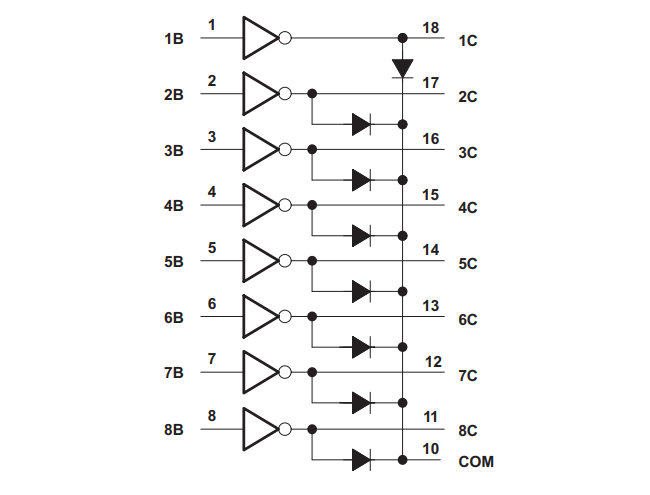
In the realm of electronics, among there exists a multitude of components, the TI ULN2803ADWR stands out as a powerful and versatile entity. In this comprehensive article, we'll delve into the intricacies of the ULN2803ADWR, uncovering its definition, key features, specifications, applications, and a closer look at its manufacturer.
ULN2803ADWR's Overview
The ULN2803ADWR is a Trans Darlington NPN semiconductor, boasting a sophisticated configuration of Octal Common Emitter setup. Its significance lies in its ability to amplify weak signals, making it an indispensable component in various electronic circuits. This 18-pin SOIC package is designed to cater to a multitude of applications, from industrial automation to consumer electronics.

△ Simplified Schematics
Key Features
Let's delve into the standout features that make ULN2803ADWR a game-changer:
· With a maximum rating of 50V, this integrated circuit offers robust performance across a wide range of operating conditions.
· The ULN2803ADWR can handle up to 30V, ensuring reliable operation in demanding environments.
· Capable of handling currents of up to 0.5A, this IC is well-suited for applications requiring moderate power handling.
· From a chilly -65°C to a scorching 150°C, the ULN2803ADWR remains steadfast in its performance, making it suitable for diverse operating environments.
· Packaged in a convenient tape and reel format, with a gull-wing lead shape for surface mounting, the ULN2803ADWR offers ease of integration into your designs.
Specifications
Now, let's delve into the technical specifications that make the ULN2803ADWR a standout choice for electronic projects:
Type | Parameter |
Type | NPN |
Configuration | Octal Common Emitter |
Number of Elements per Chip | 8 |
Maximum Collector-Emitter Voltage (V) | 50 |
Maximum Emitter Base Voltage (V) | 30 |
Maximum Continuous DC Collector Current (A) | 0.5 |
Operating Junction Temperature (°C) | -65 to 150 |
Maximum Collector-Emitter Saturation Voltage (V) | 1.1@250uA@100mA|1.3@350uA@200mA|1.6@500uA@350mA |
Minimum Operating Temperature (°C) | -40 |
Maximum Operating Temperature (°C) | 85 |
Packaging | Tape and Reel |
Mounting | Surface Mount |
Package Height | 2.35(Max) |
Package Width | 7.6(Max) |
Package Length | 11.75(Max) |
PCB changed | 18 |
Standard Package Name | SO |
Supplier Package | SOIC |
Pin Count | 18 |
Lead Shape | Gull-wing |
Applications
The versatility of the TI ULN2803ADWR lends itself to a myriad of applications across various industries. Some common applications include:
· Motor Control: Utilize the ULN2803ADWR to drive motors and actuators in robotics, automation, and industrial control systems.
· LED Matrix Displays: Harness the power of this integrated circuit to control LED matrix displays in signage, instrumentation, and decorative lighting applications.
· Relay Driving: Facilitate the operation of relays and solenoids in automotive, aerospace, and home automation systems with the ULN2803ADWR.
· Printer Head Control: Precision control of printer heads and stepper motors in printing and imaging equipment is made possible with this versatile IC.
ULN2803ADWR's Manufacturer
Texas Instruments (TI), established in 1930, is a global leader in semiconductor and technology solutions, known for its pioneering contributions to the electronics industry. Specializing in the design and manufacture of analog and digital circuits, microcontrollers, and processors, TI has played a pivotal role in shaping technological advancements across diverse sectors, including industrial, automotive, consumer electronics, and communication.
Conclusion
In conclusion, the TI ULN2803ADWR stands as a beacon of innovation in the realm of electronics. With its robust features, comprehensive specifications, and diverse applications, this integrated circuit empowers engineers and enthusiasts to push the boundaries of creativity and ingenuity.




